Research Interests
Astrophysics of Gaseous Nebulae
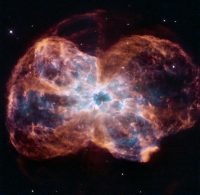
NGC 2440: K. Knoll, Hubble Heritage Team (STScI/AURA), NASA, ESA
Understanding the physics of gaseous nebulae is central to the understanding a wide variety of phenomena, from active galaxies to novae, star-forming regions to planetary nebulae. Analyzing the narrow emission lines from these objects is a powerful means to measure gas density, temperature, and chemical abundances. Some years back, I worked with Reggie Dufour to recast a FORTRAN program developed by Lick Observatory postdocs and graduate students, called FIVEL, into a powerful package in IRAF called nebular, to analyze collisionally excited emission lines. It has evidently had a significant impact on research in this area (see Shaw & Dufour 1995, PASP, 107, 896). After two decades of service, it was time to upgrade this software to a more modern language, add new features and ions, and update the atomic data. I worked with Valentina Luridiana (Instituto de Astrofisica de Canarias) and Christophe Morisset (UNAM) on the next generation of nebular, called PyNeb. The source code is freely available for use.
Planetary Nebulae in the Milky Way Galaxy
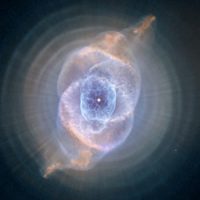
The complex morphology of the Cat’s Eye nebula: R. Corradi, Z. Tsvetanov, NASA, ESA, and STScI/AURA
Planetary nebulae (PNe) are produced by post-Asymptotic Giant Branch stars, whose progenitors span a mass range of about 1—8 M☉. This relatively brief phase of stellar evolution involves rapid evolution of the central star to very high temperatures, followed by a decline in luminosity as the star approaches white dwarf dimensions. While much is known about PNe, there are a number of fairly profound (and in some cases, simple) questions that remain unanswered: How many PNe are there in the Galaxy? What fraction of sub-supernova stars produce detectible PNe? What forces produce the complex (and beautiful!) morphologies seen in PNe? How many PNe are produced by stars in binary systems?
To probe the questions of the origin of PN shaping, the evolution of dust, and the early star-nebula interaction, I participated in Spitzer and HST programs to observe the 150 angularly smallest PNe in the Galaxy. This program has been expanded to obtain ground-based optical spectra and images to survey the nature of the interaction of PNe with the immediately surrounding ISM, and to determine precise elemental abundances to test predictions of yields form AGB stars as predicted from stellar evolution calculations.
The HST and WISE images of this sample are presented on the Compact Galactic PNe project page.
Planetary Nebulae in the Magellanic Clouds
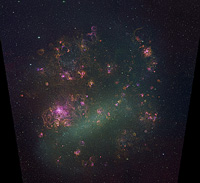
Emission-line image of the LMC: C. Smith, S. Points, the MCELS Team, and NOAO/AURA/NSF
One of the great advantages of studying Planetary Nebulae (PNe) in the Magellanic Clouds is that we know how far away they are (to ~10% accuracy). This is not so of Galactic PNe, where distances are rarely known to better than 50%. (Note: we expect parallactic distances to become available soon from the GAIA survey.) Also, the degree of interstellar extinction is low, so that it is possible to construct flux-limited, volume-complete samples of PNe in the Clouds. Study of such samples can reveal important properties, such as the intrinsic number of PNe per unit stellar luminosity in these galaxies, the distribution among PN morphological types, the range in mass of stars that form PNe, the content and evolution of dust chemistry as the PN central star evolves, and the yield of heavy elements that were generated by their parent AGB stars.
Using most ground-based telescopes, PNe in the Magellanic Clouds are angularly too small to be resolved. But they are easily resolved with Hubble Space Telescope. My colleague Letizia Stanghellini and I have been awarded hundreds of orbits of HST time, and dozens of hours with Spitzer Space Telescope to study Magellanic Cloud PNe. Take a tour of nearly 150 Planetary nebulae in the Large and Small Magellanic Clouds, as seen by HST. This represents 25–30% of all known PNe in these systems.
Molecules in Planetary Nebulae
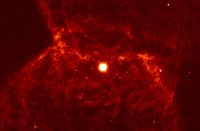
The clumped morphology of NGC 2346 in molecular Hydrogen. L. Stanghellini, R.A. shaw, and Gemini/AURA
One of the most spectacular discoveries in the Magellanic Cloud sample was the discovery of fullerenes in Planetary Nebulae. My collaborators and I also discovered that these buckyball-shaped molecules of pure Carbon (C50, C60, and C70) are also evident in Galactic PNe, and have been shown to exist in other gaseous astrophysical environmnents. We noted that fullerenes are associated with the presence of polycyclic aromatic hydrocarbons (PAHs), and we suggested that these molecules are formed during PN evolution via photochemical processing of hydrogenated amorphous carbon atoms. Graphine press release.
Astrophysics with Large Datasets
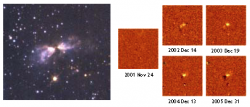
Temporal variability in LMC-RP916 (left), as revealed through difference imaging over 5 yr.
Often the scope of a question is too broad to address with a small number of targeted observations, and too costly in telescope time to justify a dedicated observing campaign. One major, unresolved question in PN research is to determine the number of PN that are produced by binary progenitors. I have been working lately with key members of the SuperMACHO and OGLE-3 survey teams to study variability in Magellanic Cloud PNe, which could indicate duplicity in the central star. A spectacular, and unexpected result of variability in the nebula itself is shown at right.

Representative types of photometric variability in PNe (top to bottom): outburst, slow decline, eclipsing binary, slow variation, temporally unresolved variation.
One of the expectations (or hopes?) from theory, based largely on momentum considerations, is that PNe with asymmetric morphology are shaped via interaction of the central star with a binary companion or massive planet. Some have argued that all visible PNe may be produced by binary central stars. This works only if the central stars are, in fact, close binaries—which lends itself to observational verification. The SuperMACHO and OGLE-3 surveys observed a large area of the central LMC in broad continuum bands, with a nightly or few-night cadence, over 5 or more years. I’ve begun to examine the light curves from a complete sample of LMC PNe for indications of binary central stars. Although there are significant selection effects, there are also many signatures that suggest binarity, including outburst events, eclipses, variability within the nebula itself, and irregular light curves. Planned follow-up photometric campaigns on the best candidates will clear up marginal cases, and will help characterize the binary systems.